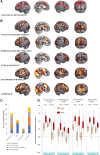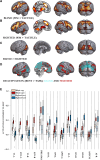The visual cortex in the blind but not the auditory cortex in the deaf becomes multiple-demand regions
- PMID: 38864500
- PMCID: PMC11449128
- DOI: 10.1093/brain/awae187
The visual cortex in the blind but not the auditory cortex in the deaf becomes multiple-demand regions
Abstract
The fate of deprived sensory cortices (visual regions in the blind and auditory regions in the deaf) exemplifies the extent to which experience can change brain regions. These regions are frequently seen to activate during tasks involving other sensory modalities, leading many authors to infer that these regions have started to process sensory information of other modalities. However, such observations can also imply that these regions are now activating in response to any task event, regardless of the sensory modality. Activating in response to task events, irrespective of the sensory modality involved, is a feature of the multiple-demands (MD) network. This is a set of regions within the frontal and parietal cortices that activate in response to any kind of control demand. Thus, demands as diverse as attention, perceptual difficulty, rule-switching, updating working memory, inhibiting responses, decision-making and difficult arithmetic all activate the same set of regions that are thought to instantiate domain-general cognitive control and underpin fluid intelligence. We investigated whether deprived sensory cortices, or foci within them, become part of the MD network. We tested whether the same foci within the visual regions of the blind and auditory regions of the deaf activated in response to different control demands. We found that control demands related to updating auditory working memory, difficult tactile decisions, time-duration judgments and sensorimotor speed all activated the entire bilateral occipital regions in the blind but not in the sighted. These occipital regions in the blind were the only regions outside the canonical frontoparietal MD regions to show such activation in response to multiple control demands. Furthermore, compared with the sighted, these occipital regions in the blind had higher functional connectivity with frontoparietal MD regions. Early deaf, in contrast, did not activate their auditory regions in response to different control demands, showing that auditory regions do not become MD regions in the deaf. We suggest that visual regions in the blind do not take a new sensory role but become part of the MD network, and this is not a response of all deprived sensory cortices but a feature unique to the visual regions.
Keywords: blind; cognitive control; deaf; multiple-demands network; neuroplasticity.
© The Author(s) 2024. Published by Oxford University Press on behalf of the Guarantors of Brain.
Conflict of interest statement
The authors report no competing interests.
Figures






Similar articles
-
Task-specific reorganization of the auditory cortex in deaf humans.Proc Natl Acad Sci U S A. 2017 Jan 24;114(4):E600-E609. doi: 10.1073/pnas.1609000114. Epub 2017 Jan 9. Proc Natl Acad Sci U S A. 2017. PMID: 28069964 Free PMC article.
-
How Auditory Experience Differentially Influences the Function of Left and Right Superior Temporal Cortices.J Neurosci. 2017 Sep 27;37(39):9564-9573. doi: 10.1523/JNEUROSCI.0846-17.2017. Epub 2017 Aug 18. J Neurosci. 2017. PMID: 28821674 Free PMC article.
-
Cross-modal activation of auditory regions during visuo-spatial working memory in early deafness.Brain. 2015 Sep;138(Pt 9):2750-65. doi: 10.1093/brain/awv165. Epub 2015 Jun 11. Brain. 2015. PMID: 26070981
-
Human brain plasticity: evidence from sensory deprivation and altered language experience.Prog Brain Res. 2002;138:177-88. doi: 10.1016/S0079-6123(02)38078-6. Prog Brain Res. 2002. PMID: 12432770 Review.
-
Developing cortex is functionally pluripotent: Evidence from blindness.Dev Cogn Neurosci. 2024 Apr;66:101360. doi: 10.1016/j.dcn.2024.101360. Epub 2024 Feb 21. Dev Cogn Neurosci. 2024. PMID: 38394708 Free PMC article. Review.
Cited by
-
Similar Computational Hierarchies for Reading and Speech in the Occipital Cortex of Sighed and Blind: Converging Evidence from fMRI and Chronometric TMS.J Neurosci. 2025 May 14;45(20):e1153242024. doi: 10.1523/JNEUROSCI.1153-24.2024. J Neurosci. 2025. PMID: 40032525
References
-
- Ding H, Qin W, Liang M, et al. . Cross-modal activation of auditory regions during visuo-spatial working memory in early deafness. Brain. 2015;138:2750–2765. - PubMed
-
- Finney EM, Fine I, Dobkins KR. Visual stimuli activate auditory cortex in the deaf. Nat Neurosci. 2001;4:1171–1173. - PubMed
-
- Kupers R, Beaulieu-Lefebvre M, Schneider FC, et al. . Neural correlates of olfactory processing in congenital blindness. Neuropsychologia. 2011;49:2037–2044. - PubMed
MeSH terms
Grants and funding
LinkOut - more resources
Full Text Sources
Medical

